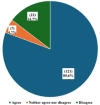DEVELOPMENT OF TOBACCO CONTROL EDUCATIONAL MATERIALS: POSTERS AND NOTEBOOKS AMONG ADOLESCENTS IN NIGERIA
- PMID: 40385724
- PMCID: PMC12082679
DEVELOPMENT OF TOBACCO CONTROL EDUCATIONAL MATERIALS: POSTERS AND NOTEBOOKS AMONG ADOLESCENTS IN NIGERIA
Abstract
Background: Tobacco use is a leading preventable cause of morbidity and mortality and poses a significant burden on fragile health systems in low- and middleincome countries (LMICs), including Nigeria. Adolescents are particularly at risk of starting to use tobacco due to factors such as misinformation and insufficient knowledge about its harmful effects. There is an urgent need for culturally appropriate, acceptable, and sustainable interventions to enhance knowledge, correct misconceptions, and promote positive behavior change regarding tobacco use. This study describes the development and validation of culturally tailored, Health Belief Model (HBM)-based educational materials (posters and notebooks) for tobacco-related health education among adolescents in Nigeria.
Methodology: The Design-Based Research (DBR) approach was used to develop posters and notebooks featuring tobacco-related messages. These messages were adapted from the World Health Organization's (WHO) Tobacco Control Manual for Schools, based on the HBM constructs, and tailored to fit the Nigerian context. The materials underwent validation through reviews by a multidisciplinary panel of experts who assessed their clarity, cultural relevance, and theoretical alignment. Subsequently, they were pre-tested among 150 adolescents from public and private schools in Ibadan, Nigeria. Feedback from the adolescents guided iterative refinements, culminating in the development of the final versions of the materials.
Results: The educational materials conveyed information on different tobacco forms, the harmful constituents, health effects, and skills to avoid tobacco use. Expert reviewers confirmed the materials' alignment with HBM constructs. Participants in the pre-test rated the materials highly, with 89.3% describing the information as ?very good? and 80.7% supporting their integration into the school curriculum.
Conclusion: The tobacco control educational posters and notebooks were found to be contextually appropriate and addressed gaps in tobacco-related knowledge and behavior change strategies. They offer a scalable model for school-based interventions in LMICs and could contribute to broader public health education efforts.
Keywords: Africa; Health-promoting schools; Smoking cessation; Teenagers; Tobacco prevention.
© Association of Resident Doctors, UCH, Ibadan.
Conflict of interest statement
The authors declare no conflict of interest.
Figures



References
-
- WHO. World Health Organization. World Health Organization; 2020. [2018 Apr 4]. Tobacco - Key facts [Internet] Available from: https://www.who.int/news-room/fact-sheets/detail/tobacco .
-
- Fagbule OF, Kanmodi KK, Samuel V, et al. Prevalence and predictors of cigarette smoking and alcohol use among secondary school students in Nigeria. Ann Ibadan Postgrad Med [Internet] 2021 Dec;19(2):112–23. Available from: https://pubmed.ncbi.nlm.nih.gov/36159039/ - PMC - PubMed
-
- U.S. Department of Health and Human Services. Preventing Tobacco Use Among Youth and Young Adults - A Report of the Surgeon General. 2012th. Atlanta, GA: U.S. Department of Health and Human Services, Centers for Disease Control and Prevention, National Center for Chronic Disease Prevention and Health Promotion, Office on Smoking and Health; 2012. pp. 1–899.
-
- Bashiru OB, Udo AU. Cigarette smoking and Awareness of Oral Health Problems of Tobacco use among Students at the University of Port-Harcourt, South-South Nigeria. World J Dent. 2014;5(4):209–12.
Publication types
LinkOut - more resources
Full Text Sources
